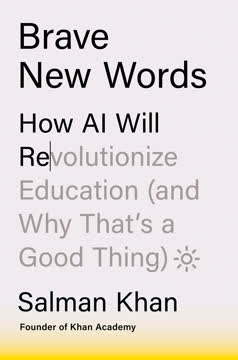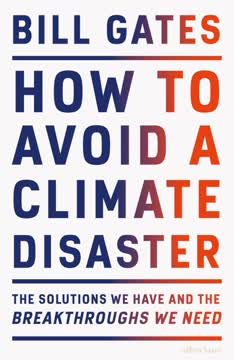نکات کلیدی
1. کووید-19 نابرابریهای بهداشتی جهانی و نیاز به آمادگی برای پاندمی را نمایان کرد
نابرابریهای بهداشتی جهانی همچنان ادامه دارد. با وجود بهبود در نرخ مرگ و میر کودکان و نتایج کلی بهداشتی در سطح جهانی، نابرابریهای قابل توجهی بین کشورهای ثروتمند و فقیر وجود دارد. کووید-19 این نابرابریها را به وضوح نشان داد، بهطوریکه کشورهای با درآمد پایین و متوسط با چالشهای بیشتری در دسترسی به واکسنها، درمانها و ملزومات پزشکی ضروری مواجه بودند.
آمادگی برای پاندمی حیاتی است. جهان بهطور عمده برای کووید-19 آماده نبود، با وجود هشدارهای کارشناسان. برای جلوگیری از پاندمیهای آینده، باید در موارد زیر سرمایهگذاری کنیم:
- بهبود سیستمهای نظارت بر بیماری
- قابلیتهای پاسخ سریع
- تقویت زیرساختهای بهداشتی در تمام کشورها
- تحقیق و توسعه واکسنها و درمانها
- همکاری و مکانیزمهای تأمین مالی جهانی
2. تشخیص زودهنگام و پاسخ سریع برای جلوگیری از شیوع بیماریها به پاندمیها ضروری است
شیوع بیماریها اجتنابناپذیر است، اما پاندمیها اختیاری هستند.
نظارت بر بیماری حیاتی است. تشخیص زودهنگام شیوعها نیازمند سیستمهای نظارتی قوی است که بتوانند:
- الگوهای غیرمعمول بیماری را زیر نظر داشته باشند
- پاتوژنهای جدید را به سرعت شناسایی کنند
- گسترش عفونتها را پیگیری کنند
- اطلاعات را بهطور جهانی به اشتراک بگذارند
قابلیتهای پاسخ سریع ضروری است. به محض شناسایی یک شیوع، اقدام سریع برای مهار آن ضروری است. این شامل:
- اعزام پرسنل آموزشدیده به مناطق آسیبدیده
- اجرای آزمایش و ردیابی تماسها
- اعمال تدابیر مناسب برای مهار
- توسعه و توزیع تشخیصها، درمانها و واکسنها میشود
تیم پیشنهادی پاسخ و بسیج جهانی اپیدمی (GERM) بهعنوان یک منبع جهانی اختصاصی برای هماهنگی این تلاشها و اطمینان از پاسخ سریع و مؤثر به تهدیدات نوظهور عمل خواهد کرد.
3. مداخلات غیر دارویی ابزارهای حیاتی در کنترل گسترش بیماری هستند
اگر به نظر میرسد که شما بیش از حد واکنش نشان میدهید، احتمالاً کار درستی انجام میدهید.
اجرای زودهنگام کلیدی است. مداخلات غیر دارویی (NPI) مانند ماسک، فاصلهگذاری اجتماعی و قرنطینه میتوانند در صورت اجرای زودهنگام و مداوم بهطور قابل توجهی انتقال بیماری را کاهش دهند. در حالی که این تدابیر ممکن است اختلالاتی ایجاد کنند، اما اغلب مؤثرترین ابزارهای موجود در مراحل اولیه یک شیوع هستند.
رویکردهای متناسب ضروری است. اثربخشی NPIها میتواند بسته به:
- شرایط محلی و عوامل فرهنگی
- چگالی جمعیت و جمعیتشناسی
- ملاحظات اقتصادی
- ظرفیت سیستم بهداشت و درمان متفاوت باشد
دولتها و مقامات بهداشت عمومی باید بهدقت مزایای NPIها را با تأثیرات منفی بالقوه آنها متعادل کنند و استراتژیها را با توجه به اطلاعات جدید تطبیق دهند.
4. سرمایهگذاری در توسعه واکسن و درمان میتواند جان میلیونها نفر را نجات دهد
نوآوری چکش من است و سعی میکنم آن را بر روی هر میخی که میبینم استفاده کنم.
توسعه تسریعشده ممکن است. توسعه سریع واکسنهای کووید-19 نشان داد که با منابع کافی و همکاری جهانی، میتوان واکسنهای ایمن و مؤثر را در زمان رکوردی ایجاد کرد. عوامل کلیدی شامل:
- پیشرفت در فناوریهای واکسن (مانند پلتفرمهای mRNA)
- فرآیندهای نظارتی سادهشده
- آزمایشهای بالینی موازی و افزایش مقیاس تولید
- همکاری جهانی بین محققان، شرکتها و دولتها است.
سرمایهگذاری مداوم حیاتی است. برای آمادگی در برابر پاندمیهای آینده، باید:
- تحقیق در مورد واکسنهای جهانی و آنتیویروسهای وسیعالطیف را تأمین مالی کنیم
- تکنیکهای جدید کشف دارو و فرآیندهای تولید را توسعه دهیم
- سیستمهای توزیع و تحویل واکسن را بهبود بخشیم
- به تردید در مورد واکسن و اطلاعات نادرست رسیدگی کنیم
5. تقویت سیستمهای بهداشتی در سطح جهانی برای پیشگیری از پاندمی ضروری است
اگر شما مهماندار هستید، احتمالاً شغل شما در سالهای اخیر بهطور قابل توجهی تغییر کرده است، اما نه بهدلیل افزایش دیجیتالیسازی.
سیستمهای بهداشتی قوی پایهگذار آمادگی هستند. زیرساختهای قوی بهداشت اولیه و بهداشت عمومی برای:
- تشخیص و پاسخ زودهنگام به شیوعها
- اجرای مؤثر تدابیر مهار
- توزیع عادلانه واکسنها و درمانها
- مدیریت نیازهای بهداشتی روزمره در زمان بحرانها ضروری است.
سرمایهگذاری در بهداشت جهانی سودآور است. بهبود سیستمهای بهداشتی در کشورهای با درآمد پایین و متوسط نهتنها جانها را نجات میدهد، بلکه:
- خطر گسترش بیماریهای جهانی را کاهش میدهد
- ثبات و رشد اقتصادی را تقویت میکند
- امنیت و همکاری جهانی را افزایش میدهد
مناطق کلیدی برای سرمایهگذاری شامل:
- آموزش و نگهداشتن کارکنان بهداشتی
- بهبود زنجیرههای تأمین ملزومات پزشکی
- ارتقاء تأسیسات و تجهیزات بهداشتی
- تقویت قابلیتهای جمعآوری و تحلیل دادهها است.
6. تمرین و آمادگی از طریق شبیهسازیها کلید پاسخ مؤثر به شیوعها است
به این هزینهها بهعنوان خیریه یا حتی کمکهای توسعهای سنتی فکر نکنید. درست مانند هزینههای دفاعی، این نیز بخشی از مسئولیت هر کشور برای اطمینان از ایمنی و امنیت شهروندانش خواهد بود.
شبیهسازیهای منظم آمادگی را بهبود میبخشند. انجام تمرینات کامل که سناریوهای پاندمی را شبیهسازی میکند میتواند:
- نقاط ضعف در سیستمهای پاسخ را شناسایی کند
- هماهنگی بین آژانسها و بخشهای مختلف را بهبود بخشد
- برنامهها و پروتکلهای اضطراری را آزمایش و اصلاح کند
- پرسنل را با نقشها و مسئولیتهایشان آشنا کند
یادگیری از تجربیات گذشته حیاتی است. تحلیل موفقیتها و شکستهای شیوعها و تلاشهای پاسخ قبلی میتواند به آمادگی آینده کمک کند. این شامل:
- مطالعه اثربخشی مداخلات مختلف
- شناسایی بهترین شیوهها برای ارتباط و هماهنگی
- رسیدگی به شکافهای زنجیره تأمین و تخصیص منابع
- بهبود فرآیندهای تصمیمگیری در زمان بحرانها است.
7. همکاری جهانی و تأمین مالی برای جلوگیری از پاندمیهای آینده ضروری است
مقابل بیتوجهی، ترس نیست. عمل است.
پیشگیری از پاندمی نیازمند تعهد جهانی است. هیچ کشوری بهتنهایی نمیتواند از پاندمیها جلوگیری کند. همکاری بینالمللی برای:
- به اشتراکگذاری دادهها و منابع
- هماهنگی تلاشهای تحقیق و توسعه
- اطمینان از دسترسی عادلانه به واکسنها و درمانها
- اجرای تدابیر بهداشت عمومی یکسان در مرزها ضروری است.
تأمین مالی پایدار حیاتی است. پیشگیری از پاندمی نیازمند سرمایهگذاری بلندمدت در:
- زیرساختهای بهداشت جهانی
- تحقیق و توسعه ابزارها و فناوریهای جدید
- سیستمهای نظارت و هشدار زودهنگام
- قابلیتهای پاسخ اضطراری است.
دولتها، سازمانهای بینالمللی و بخش خصوصی باید با هم همکاری کنند تا مکانیزمهای تأمین مالی پایدار ایجاد کنند و اطمینان حاصل کنند که آمادگی برای پاندمی همچنان یک اولویت جهانی باقی بماند، حتی در غیاب تهدید فوری.
آخرین بهروزرسانی::
FAQ
What's How to Prevent the Next Pandemic about?
- Pandemic preparedness focus: The book emphasizes strategies to prevent future pandemics, learning from COVID-19. Gates advocates for a global response team and improved health systems for early outbreak detection and response.
- Learning from COVID-19: Gates reflects on past mistakes and outlines actionable steps for better preparedness. He believes the world can provide basic care to everyone and be ready for emerging diseases.
- Innovative solutions: The book proposes methods like improved diagnostics, vaccine development, and public health strategies to combat infectious diseases effectively.
Why should I read How to Prevent the Next Pandemic?
- Timely insights: The book offers crucial insights into preparing for future pandemics amidst ongoing global health challenges. Gates shares his extensive experience in global health and philanthropy.
- Actionable recommendations: It provides practical steps for governments, organizations, and individuals to improve pandemic preparedness, emphasizing investment in health systems and research.
- Informed perspective: Gates draws on his work with the Gates Foundation and collaborations with health experts, offering a well-rounded view of the issues.
What are the key takeaways of How to Prevent the Next Pandemic?
- Pandemic prevention team: Gates advocates for a global team to monitor and respond to outbreaks, responsible for early detection, data sharing, and coordinating responses.
- Invest in health systems: Strengthening health systems in low- and middle-income countries is crucial for effective pandemic response, enabling early outbreak detection and management.
- Rapid vaccine development: The book highlights the need for quick vaccine development and equitable distribution, aiming for global delivery within six months of identifying a new pathogen.
What are the best quotes from How to Prevent the Next Pandemic and what do they mean?
- “Outbreaks are inevitable, but pandemics are optional.” This quote emphasizes that while diseases will spread, effective systems and preparedness can prevent them from becoming global crises.
- “If it looks like you’re overreacting, you’re probably doing the right thing.” Gates stresses the importance of early and decisive action during an outbreak, suggesting that caution can save lives.
- “We need to invest in all the elements of a robust health system.” This statement highlights the need for comprehensive health infrastructure to manage diseases effectively, linking prevention and treatment.
What specific methods does Bill Gates suggest for preventing future pandemics in How to Prevent the Next Pandemic?
- GERM team establishment: Gates proposes creating a Global Epidemic Response and Mobilization team to monitor outbreaks, coordinate responses, and ensure countries are prepared for threats.
- Enhance disease surveillance: The book emphasizes improving disease detection and reporting mechanisms, investing in technology and training for quick outbreak identification.
- Develop universal vaccines: Gates advocates for research into vaccines that protect against multiple virus strains, ensuring better protection against future outbreaks.
How does How to Prevent the Next Pandemic address the issue of vaccine distribution?
- Equitable access: Gates stresses the importance of making vaccines available to everyone, especially in low-income countries, highlighting organizations like Gavi's role in facilitating access.
- Rapid manufacturing: The book outlines strategies for scaling up vaccine production quickly in response to threats, emphasizing coordinated global efforts for timely distribution.
- Vaccine hesitancy: Gates acknowledges challenges posed by misinformation and hesitancy, advocating for clear communication and education to build trust and encourage uptake.
What role does technology play in pandemic prevention according to How to Prevent the Next Pandemic?
- Innovative diagnostics: Gates discusses the importance of rapid and accurate diagnostic tests for early infection identification, highlighting technological advancements for widespread testing.
- Data sharing: The book emphasizes robust data systems for tracking outbreaks and sharing information globally, enhancing collaboration among health organizations and governments.
- Vaccine development technologies: Gates points to mRNA technology as a breakthrough for rapid vaccine development, advocating for continued investment in such technologies.
How does How to Prevent the Next Pandemic suggest improving global health systems?
- Strengthening infrastructure: Gates emphasizes investing in health systems in low- and middle-income countries, including training healthcare workers and ensuring access to medical supplies.
- Building trust: The book discusses fostering trust between communities and health authorities, suggesting transparent communication and community engagement for effective interventions.
- Regular drills: Gates advocates for regular simulations and drills to test health systems' readiness, identifying weaknesses and improving response strategies.
What are the challenges in detecting outbreaks early as discussed in How to Prevent the Next Pandemic?
- Underreporting: Gates highlights that many illnesses go unreported, especially in low-income countries with weak health systems, hindering early detection and response.
- Limited healthcare access: Barriers to healthcare can prevent individuals from seeking treatment and reporting symptoms, particularly in rural and underserved areas.
- Surveillance system improvement: Gates argues for investing in technology and training to enhance disease surveillance systems for early outbreak detection.
How does How to Prevent the Next Pandemic propose to address misinformation about health measures?
- Clear communication: Gates emphasizes the need for transparent and accurate information from health authorities to counter misinformation and build public trust.
- Community engagement: The book suggests involving local leaders in health messaging to reach diverse populations, using trusted figures to disseminate accurate information.
- Social media use: Gates discusses using social media responsibly to promote accurate health information and combat false claims.
What lessons from COVID-19 does How to Prevent the Next Pandemic highlight for future preparedness?
- Early action importance: Gates stresses that timely interventions can significantly reduce outbreak impact, learning from countries that acted quickly to inform future responses.
- Global collaboration need: The book highlights that pandemics require coordinated global responses, with collaboration among countries, organizations, and health experts crucial for effective management.
- Research investment: Gates argues for ongoing investment in health research and technology, developing new vaccines, treatments, and diagnostic tools for emerging diseases.
How does How to Prevent the Next Pandemic address vaccine inequity?
- Highlighting disparities: Gates discusses differences in vaccine access between wealthy and low-income countries, emphasizing the dire consequences for global health.
- Moral obligation: The book argues for equitable vaccine access as a moral imperative, stressing that health disparities affect everyone and require collective efforts to address.
- Improvement strategies: Gates outlines strategies like second-source agreements and tiered pricing to make vaccines more accessible to underserved populations.
نقد و بررسی
کتاب چگونه از پاندمی بعدی جلوگیری کنیم نقدهای متفاوتی دریافت کرد. بسیاری از منتقدان سبک نوشتاری شفاف گیتس، رویکرد عملی و پیشنهادات مبتنی بر شواهد او برای بهبود آمادگی جهانی در برابر پاندمیها را ستودند. حامیان، دیدگاههای او در مورد توسعه واکسن، آزمایش و تقویت سیستم بهداشتی را تحسین کردند. با این حال، منتقدان گیتس را به ترویج استبداد پزشکی متهم کرده و صلاحیتهای او را زیر سوال بردند. برخی از منتقدان کتاب را ساده یا بدیهی یافتند، در حالی که دیگران آن را یک مطالعه ضروری دانستند. جنجالهای پیرامون خود گیتس بسیاری از نقدهای منفی را تحت تأثیر قرار داد، به طوری که برخی از خوانندگان به دلیل دیدگاههایشان نسبت به نویسنده، کتاب را بهطور کامل رد کردند.
Similar Books
















